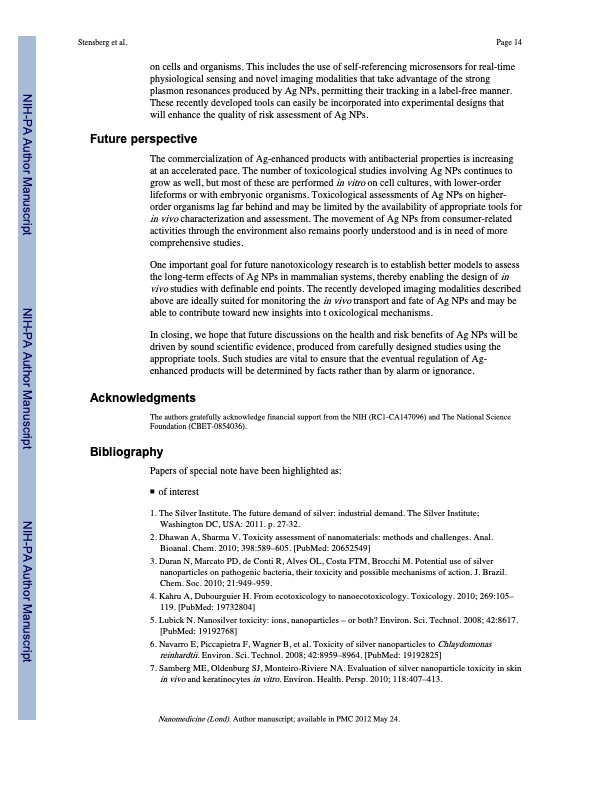
PDF Publication Title:
Text from PDF Page: 014
Stensberg et al. Page 14 on cells and organisms. This includes the use of self-referencing microsensors for real-time physiological sensing and novel imaging modalities that take advantage of the strong plasmon resonances produced by Ag NPs, permitting their tracking in a label-free manner. These recently developed tools can easily be incorporated into experimental designs that will enhance the quality of risk assessment of Ag NPs. Future perspective The commercialization of Ag-enhanced products with antibacterial properties is increasing at an accelerated pace. The number of toxicological studies involving Ag NPs continues to grow as well, but most of these are performed in vitro on cell cultures, with lower-order lifeforms or with embryonic organisms. Toxicological assessments of Ag NPs on higher- order organisms lag far behind and may be limited by the availability of appropriate tools for in vivo characterization and assessment. The movement of Ag NPs from consumer-related activities through the environment also remains poorly understood and is in need of more comprehensive studies. One important goal for future nanotoxicology research is to establish better models to assess the long-term effects of Ag NPs in mammalian systems, thereby enabling the design of in vivo studies with definable end points. The recently developed imaging modalities described above are ideally suited for monitoring the in vivo transport and fate of Ag NPs and may be able to contribute toward new insights into t oxicological mechanisms. In closing, we hope that future discussions on the health and risk benefits of Ag NPs will be driven by sound scientific evidence, produced from carefully designed studies using the appropriate tools. Such studies are vital to ensure that the eventual regulation of Ag- enhanced products will be determined by facts rather than by alarm or ignorance. Acknowledgments The authors gratefully acknowledge financial support from the NIH (RC1-CA147096) and The National Science Foundation (CBET-0854036). Bibliography Papers of special note have been highlighted as: ▪ of interest 1. The Silver Institute. The future demand of silver: industrial demand. The Silver Institute; Washington DC, USA: 2011. p. 27-32. 2. Dhawan A, Sharma V. Toxicity assessment of nanomaterials: methods and challenges. Anal. Bioanal. Chem. 2010; 398:589–605. [PubMed: 20652549] 3. Duran N, Marcato PD, de Conti R, Alves OL, Costa FTM, Brocchi M. Potential use of silver nanoparticles on pathogenic bacteria, their toxicity and possible mechanisms of action. J. Brazil. Chem. Soc. 2010; 21:949–959. 4. Kahru A, Dubourguier H. From ecotoxicology to nanoecotoxicology. Toxicology. 2010; 269:105– 119. [PubMed: 19732804] 5. Lubick N. Nanosilver toxicity: ions, nanoparticles – or both? Environ. Sci. Technol. 2008; 42:8617. [PubMed: 19192768] 6. Navarro E, Piccapietra F, Wagner B, et al. Toxicity of silver nanoparticles to Chlaydomonas reinhardtii. Environ. Sci. Technol. 2008; 42:8959–8964. [PubMed: 19192825] 7. Samberg ME, Oldenburg SJ, Monteiro-Riviere NA. Evaluation of silver nanoparticle toxicity in skin in vivo and keratinocytes in vitro. Environ. Health. Persp. 2010; 118:407–413. Nanomedicine (Lond). Author manuscript; available in PMC 2012 May 24. NIH-PA Author Manuscript NIH-PA Author Manuscript NIH-PA Author ManuscriptPDF Image | Toxicological studies on silver nanoparticles

PDF Search Title:
Toxicological studies on silver nanoparticlesOriginal File Name Searched:
nihms-316964.pdfDIY PDF Search: Google It | Yahoo | Bing
Turbine and System Plans CAD CAM: Special for this month, any plans are $10,000 for complete Cad/Cam blueprints. License is for one build. Try before you buy a production license. More Info
Waste Heat Power Technology: Organic Rankine Cycle uses waste heat to make electricity, shaft horsepower and cooling. More Info
All Turbine and System Products: Infinity Turbine ORD systems, turbine generator sets, build plans and more to use your waste heat from 30C to 100C. More Info
CO2 Phase Change Demonstrator: CO2 goes supercritical at 30 C. This is a experimental platform which you can use to demonstrate phase change with low heat. Includes integration area for small CO2 turbine, static generator, and more. This can also be used for a GTL Gas to Liquids experimental platform. More Info
Introducing the Infinity Turbine Products Infinity Turbine develops and builds systems for making power from waste heat. It also is working on innovative strategies for storing, making, and deploying energy. More Info
Need Strategy? Use our Consulting and analyst services Infinity Turbine LLC is pleased to announce its consulting and analyst services. We have worked in the renewable energy industry as a researcher, developing sales and markets, along with may inventions and innovations. More Info
Made in USA with Global Energy Millennial Web Engine These pages were made with the Global Energy Web PDF Engine using Filemaker (Claris) software.
Infinity Turbine Developing Spinning Disc Reactor SDR or Spinning Disc Reactors reduce processing time for liquid production of Silver Nanoparticles.
| CONTACT TEL: 608-238-6001 Email: greg@infinityturbine.com | RSS | AMP |